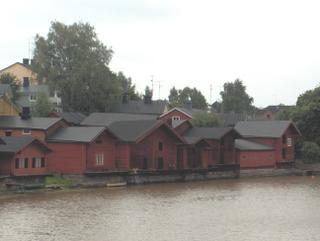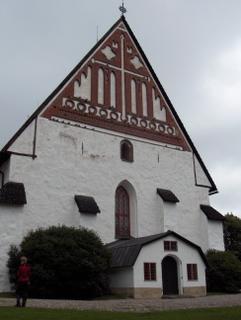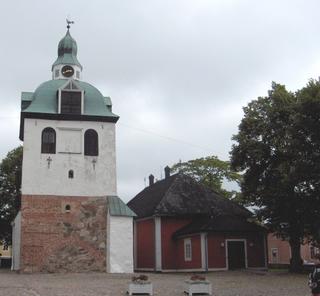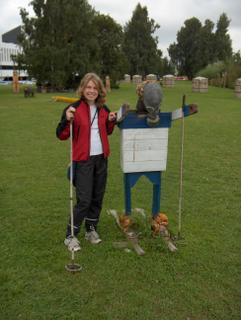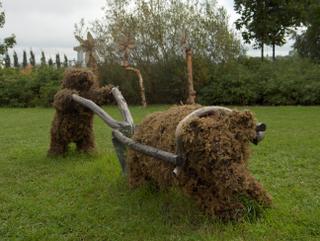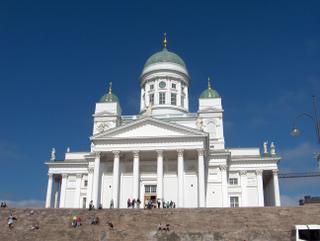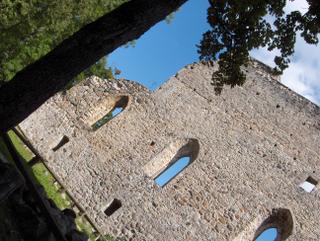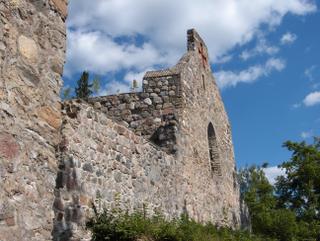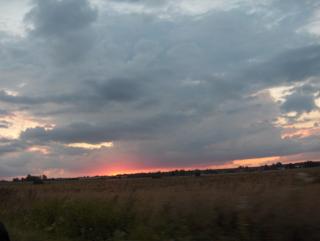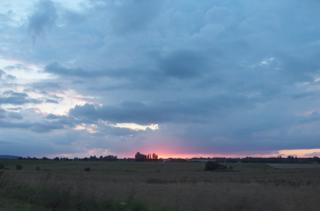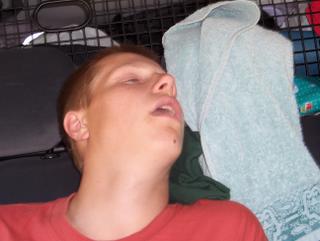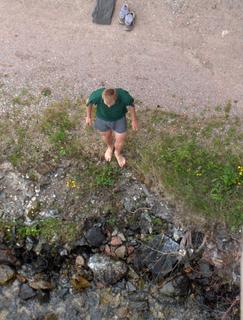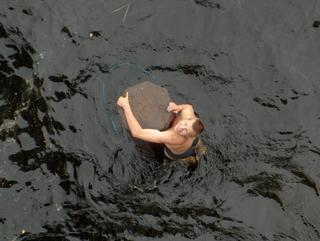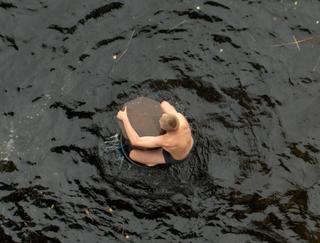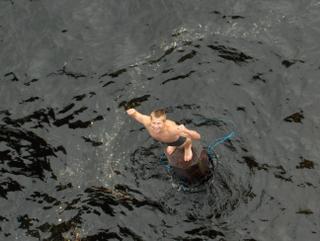Ding ding, beng beng není ani zvuk motoru, ani zvuk pneumatik, nýbrž kultovní refrén, který provázel oddané fanoušky a fanynky Crazy Frogs na jejich severské výpravě. Cílem akce bylo zjistit, jak populární jsou Crazy Frogs v Polsku, Pobaltí a samotném Suomilandu. Kromě toho snad i trošku poběhat po plotnách (ano, to vy v Prima vařečce neumíte!) a vyzkoušet squatt ve finských národních parcích.
Na cestě tam zaujala Olesznice, partnerské město Chrudimi. Jörgen se zde cítil jako doma, a možná právě proto zde úplně zasekli dopravu. Co my s tím? Navrhujeme Polsko vyloučit z EU! (Anebo jim naopak přispět na transevropskou dálniční síť.) To nám trošku nabouralo itinerář. Zařízli jsme to tedy až ve dvě ráno na odpočívadle v Litvě, kousek před hranicí s Lotyšskem. Odměnou bylo ranní pozorování, zda nechutné záchodky plné “junk&shit” na celé podlaze, všech stěnách a možná i stropě někdo využije; a vskutku, Litevci sem chodili náruživě (jakkoli si některé jemnocitné slečny zacpávaly nos).
Další zastávka v Siguldě byla trefa do černého (resp. do Oty Černého). Do hradu jsme se vkradli přes živý plot, poběhali jsme v okolí, vyběhli si kopec od lanovky a pokochali okolím. Došlo i na koupačku v raftové říčce Gauja. V místě se silnějším proudem Jörg plaval kraulem proti proudu a za minutu se posunul cca o 1 metr vpřed. On prosto moloděc.
Pak ale ukázková blamáž. Dle instrukcí Libora Zhustasmutného jsme vyrazili do terénu Short Distance z JWOC 2001 – text hovořil jasně: 20km severně od Polvy ve východním Estonsku. Směrem na východ k hranicím vedla dálnice, po které téměř nikdo nejel – že by se z Pobaltí nikomu nechtělo do Běloruska a Ruska…? Před Polvou jsme začali panikařit – copak můžeme lokalizovat mapu na OB, když jediné, co máme, je mapa světa? A když na mapě OB je jedinou jasnou věcí silnička jdoucí JVV-SZZ směrem? V tu chvíli jsme u silnice natrefili na mapku se silničkami v okolí. Bystré HPéčko ji zvěčnilo a byli jsme tedy rozhodnuti, že navigaci dokončíme s pomocí bystrého oka. V Polvě se nám tento postup rozležel v hlavě a na benzínce jsme raději konzultovali lokaci s pomocí jedné místní mapy. Pumpařka ani místní dědýsové nám příliš nepomohli. A hle – na mapě se vyloupla krásná silnička JVV-SZZ směrem, přesně 20 km na sever, no to bude ono. Když jsme však přijeli na místo, bylo nadmíru jasné, že to ono není (John Lennon by řekl: to není Yoko Ono). Přesnější lokalizaci jsme tudíž si objednali přes virtuální základnu, Libora Jirků, sedícího doma u netu. Po chvíli přišla spásná SMS – mapa leží údajně přesně 20km od Polvy. Ne ale na sever, ale na západ. Konkrétně na východ od hlavní silnice u vesnice Sadverna. Krása! Spali jsme s představou o-la-la tréninku ve stopách estonského JWOCu. Když jsme ale přijeli ráno do Sadverny, započalo hledání inkriminované JVV-SZZ silničky. Nu, projeli jsme jich asi 20 a žádná z nich to nebyla. V momentu největšího zoufalství jsme zaparkovali, poptali se místních dřevorubců a pak hurá na blind do lesa, třeba to najdeme… Samozřejmě jsme to nenašli, bodejť by jo. Zato jsme objevili krásné oblasti plné zeleného humusu, posekaných stromků, pasek, kopřiv a na závěr vosí hnízdo, které Kamču šeredně pobodalo. Polva never more.
Azyl ve Finsku po první dva/tři dny poskytla středoevropským běžencům klubovna Keravanu Uh-zde-je-něco-hrozně-finského-atu. Keravan nabídl něco mnohem lepšího než karavan, který jsme očekávali po mohutných varování od Petry. Nakonec byla k dispozici i epesní sauna s březovými větvičkami, krásně vyhřátý sklep na spaní a plně funkční kuchyňka.
Na prvních mapkách jsme otestovali místní lesíky, pochopili styl mapování a generalizaci; šedé plotny byly poměrně dost jednoznačné, srázy na svazích rovněž, žádná hard-core Skandinávie. Běželi jsme vždy každý na sebe, časové srovnání neexistovalo, třeba Jörg chodil do lesa pod heslem “hodinky neuznávám, navíc tu stejně mají posunutý čas”.
KeU vydrželo jako opěrný bod k výpravám do Porvoo/Borgaa a do Helsinek. To první bylo maličké až k uzoufání. Naopak Helsinky mají hodně do sebe, i když novoklasicismus není nic, z čeho by člověk padal v údivu na pozadí. Děvčata naplánovala výstavu leteckých fotografií z celého světa, která opravdu stála za vidění. Zato Jörg chtěl jen a jen do muzea sportu, kam jsme ho nakonec nepustili, ale to, že neviděl sbírku plaveckých čapek jsme mu aspoň kompenzovali okružní jízdou kolem Olympijského stadionu, kde před 53 lety exceloval Zátopek a před několika dny jeho etiopští nástupci.
Nuuksio: pěkná procházka po parku, soutěž v hledání zmutovaných obřích borůvek, koupání na Adama a Evu, squatt ve srubu, ráno výborný OB. Turku: déšť, dojmy mlhavé, mlžné, zamlžené až nijaké. Ani hrad, který se má údajně majestátně tyčit nad městem (ale člověk ho stěží objeví), to nevytrhl.
Cestou v jednom järvi došlo na deep-water-training, vodní, bahenní a řasovou bitvu. A pak došlo na vícedenní orienťák “po stopách Fin5 2005”. Nevadilo nám ani, že v okolí probíhala honitba – my máme přece výrazné dresy! Navzdory barvě dresu a slonímu pohybu se mi nicméně podařilo spatřit obrovské zvíře s velkými parohy, ale v tom mžiku lze stěží říct, zda to byl los nebo sob. Sob či los, toť stejně komplikovaná otázka, jako jestli člověk potkal Apače nebo Siouxe. Takže do deníku píšu zahlédnutí losoba (resp. sobola).
Déšť trošku zkazil tréninky, mizíme do parku Helvetinjärvi. Průvodci slibují rozeklanou soutěsku s úžasným jezerem, po návštěvě Norska je to ale jako chlubit se s Velorexem na frankfurtském autosalónu. Jinak je navzdory dešti park parádní, nabízí mechové okolí, rašeliniště, kde si Petra umývá adidasky (cestou zpět ji šerpa Jörg nese v náručí), ohniště, kde hodinu rozžeháváme oheň a nakonec i srub na dříví, který jako správní Češi obsazujeme jako hotýlek na jednu noc.
A pak nás čeká už jen spousta kilometrů do Čech. Na severu stavíme na obhlídce ostrovního národního parku Päijänne. Zúžená pevnina mezi jezery až na několik metrů připomíná molo. Zde Jörg hraje úspěšnou jednoaktovku “Bohatýr dobývá bójku”. Cestou zpět do Helsinek se konečně dostáváme do vysněné kouřové sauny u Kuusijärvi. Přežíváme i situaci, kdy šílená Finka rozlévá barel vody a spouští tsunami vodní páry. Jiný šílený Fin zase spřádá spiklenecké teorie o tom, jak Němci a Amíci barbarsky rozvracejí svět – že by se mu přehříval mozek? Jörg se od šílené Finky poučil a zkusil mučení parou v malé sauně na mé osobě – a vskutku moc nechybělo a v autě by autor tohoto článku scházel, zato by se zvedla statistika infarktů vedená finským ministerstvem zdravotnictví.
Nu a k cestě zpět – přespáváme v teepee ve Finsku, poté prohlídka Tallinu a Rigy (obojí hezčí než celé Finsko), trénink kousek od moře v Estonsku, kochačka dunami v Lotyšsku, jízda přes noc Litvou a Polskem (highly recommended) a samozřejmě neskutečná ranní zácpa ve Wroclawi – toto město by potřebovalo hodně silné projímadlo. Do toho všeho nás pronásleduje přízrak Mr. Lonely a jeho “lonely, I am so lonely, I have nobody, only my own…”.
Co na závěr? Vylepšili jsme mapovou formu, což Jörg hned viděl o víkendu v H21A. Ověřili jsme, že když do národních parků ve Skandinávii, tak jedině do Norska. Připravili jsme se na terény Jukoly (i když ji stejně asi nikdy nepoběžíme, my radši Tiomilu). A rozhodli se, že se příště jedeme saunovat do Somalilandu místo do Suomilandu – zní skoro stejně, tak to bude asi stejně fajnové.









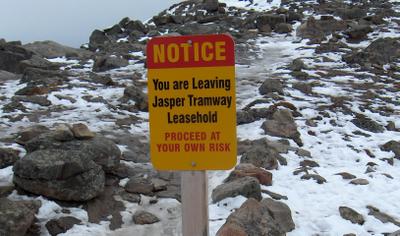 Proceed at your own risk!
Proceed at your own risk!




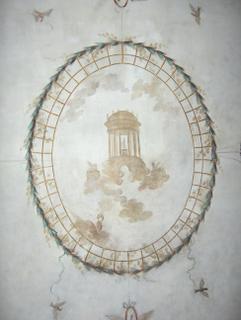




 Water Jewels, Not Watery At All
Water Jewels, Not Watery At All



